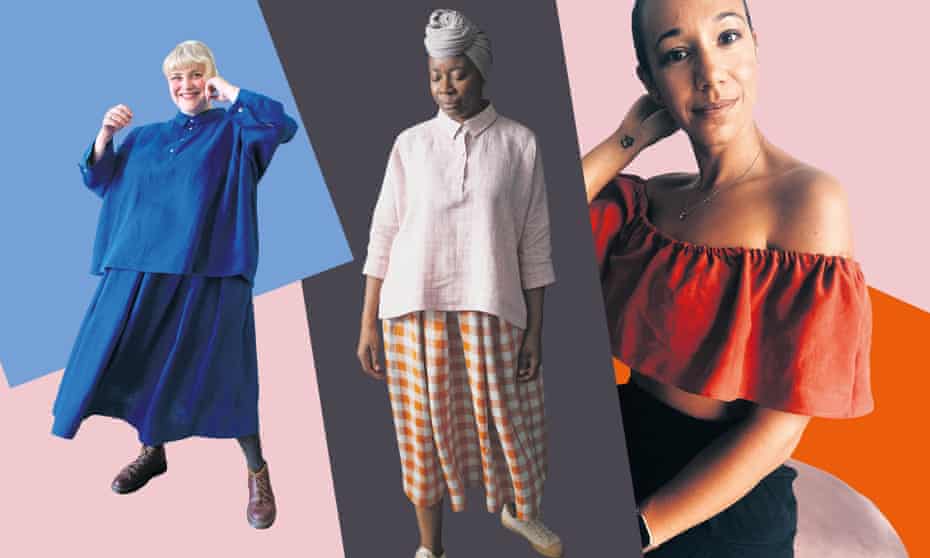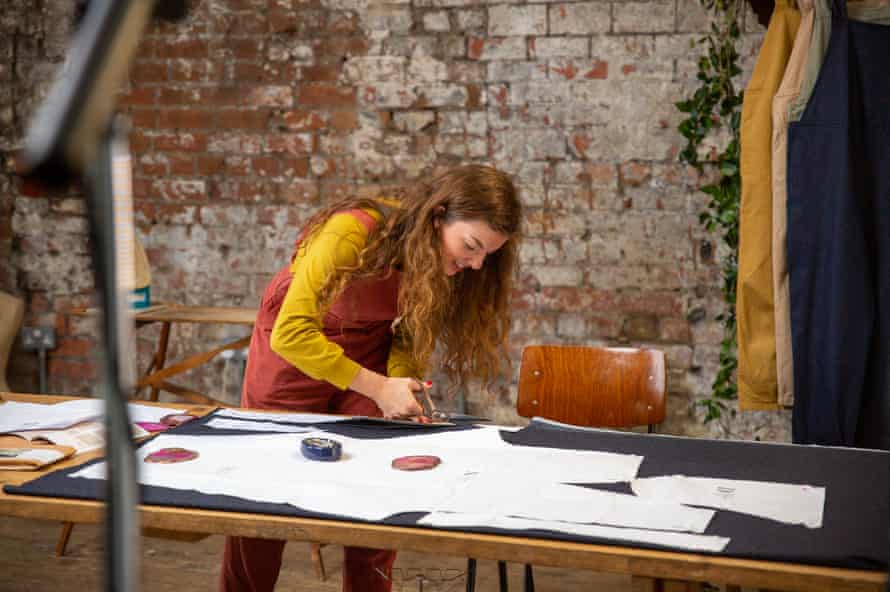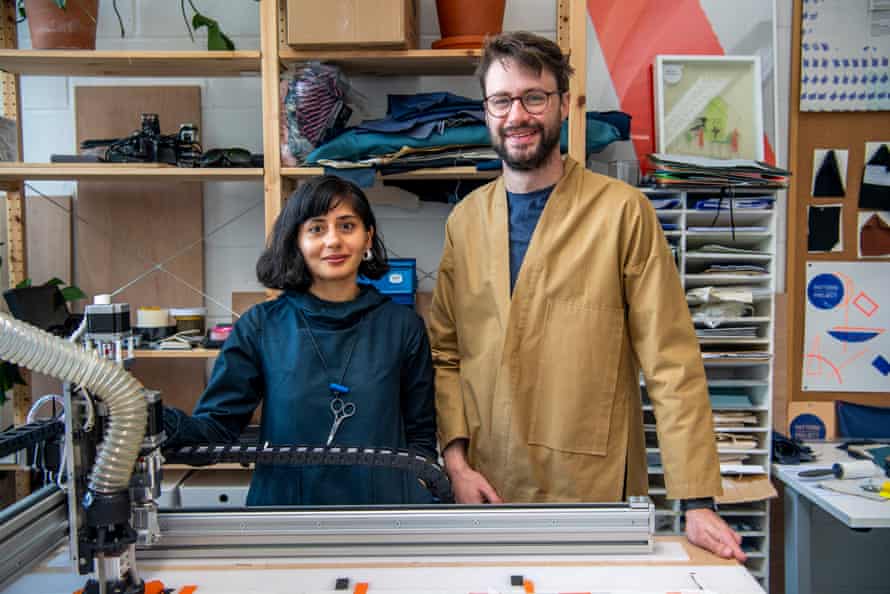Sew it yourself! Inside the zero-waste, zero-sweatshop fashion revolution

In lockdown, thousands of people began making their own clothes for the first time – a movement born of creativity and conscious consumption
My foot hovers nervously over the sewing machine pedal. I am cautiously working my way through a sew-it-yourself kit produced by Pattern Project, a “microfactory” startup in south London. It has pioneered a laser-cutting machine that can cut patterns on demand, with minimal waste. The pieces for the dropped-sleeve dress that I am sewing have been snipped to my precise measurements by a zippy little laser, which whizzes over the crisp Irish linen, scorching faint seam guides into the fabric so I know exactly where to sew.
Pattern Project’s founders, Shruti Grover, 34, and Simon Johnson, 35 – partners in life and in business – are seeking funding for their first shop. A “22nd-century” vision of fashion, says Grover, it will hold no stock, but will sell custom-fit clothing that is laser-cut in front of you within minutes, out of local, ethical and sustainable fabrics – and then sewn by you.
They have already collaborated on a zero-waste pattern for the latest collection by the fashion designer Phoebe English, while last weekend they exhibited at the V&A in west London as part of the London Design festival.

Pattern Project is at the cutting edge of a make-your-own-clothes revival, but it is not the only business facilitating home-sewn fashion. The catalyst was Covid. “We took six weeks of sales in one day over lockdown,” says Michael Jones of Merchant & Mills, which sells whatever you might need – patterns, fabric, tools and online tutorials – to sew your own. Even now, 18 months on, sales are 50% higher than before the pandemic.
Shedding its “mumsy”, hobbyist image, the sew-it-yourself (SIY) movement has become something more modern, sustainably minded and social. For starters, sewers have been rebranded as “sewists” – because who would want to be mistaken for a waste pipe? Plus, thanks to a new wave of independent pattern-makers, it is not hard to find on-trend designs, downloadable in pdf format anywhere in the world.
“When I tell people that I’m making my own clothes, they look at me like: ‘Oh, you poor thing,'” says Leila d’Angelo, a 34-year-old insurance broker who dusted down her sewing machine during the second English lockdown. “Then I come in with a bustier dress and they’re like: ‘Sorry, what? That’s not what I was expecting.'”

According to Jones, the new customers are “young and mostly female, against fast fashion and much more switched on about environmental issues”. Many are motivated to sew because it enables them to avoid sweatshop production. “A lot of people are clear that cutting and sewing is where the exploitation happens,” says Lydia Morrow, a 25-year-old Glasgow-based sewing influencer who shares microtutorials on Instagram Stories. “I can cut that out now.”
There is plenty of support available for newbie sewists, too. The Fashion District festival, a five-day celebration of sustainable fashion that took place last week in Stratford, east London, dedicated a third of this year’s programme to maker workshops, including a tutorial on upcycling scarves into kimonos, hosted by the community interest company Trashion Factory. “There’s a huge appetite for people to be involved in their own fashion,” says Helen Lax, the festival’s founder. “This is a different incarnation of the good life. Rather than just following a pattern, the maker community is going off-grid and having a go. It’s about being able to take control of your style.”
For many sewists, the face mask was a gateway drug. After spotting a callout for 500 cloth masks from a homeless charity, Lydia Higginson, the founder of Made My Wardrobe sewing kits, rallied her followers to help. “It was a quick win – the perfect small challenge to get people back on their machines,” she says. “And then they were like: ‘What else can I make?'”

The new generation of mail-order sewing kits – complete with pattern, sustainable fabric and the promise of a clean conscience – serves as an outstretched hand waiting to guide nascent sewists through the daunting process of dressmaking. Made My Wardrobe, which has sold 20,000 dungarees kits (from GBP58) and patterns (GBP12.50) since launching them two years ago, also offers kits for underwear, period pants and swimwear, using recycled denim and recycled fishing yarn (in UK sizes 6 to 24). If you get stuck, Made My Wardrobe and Pattern Project offer “sew-along” video tutorials.
While you will find only British and European organic fabrics at Pattern Project (as well as an Italian polyamide that they claim will biodegrade about five years after disposal), the bigger fashion problem it wants to solve is overstock. It is estimated that 20% of the 100bn items of clothing produced each year are not sold; they are then usually buried, shredded or burned. “Brands always over-order,” says Grover. “It’s cheaper to produce more and sell at mad discounts later than it is to produce less, but higher-quality, stuff.” Pattern Project’s ultimate goal is to see its zero-waste laser in fashion stores and haberdasheries across the country, so clothes can be cut and sewn on demand, affordably and quickly.
In the meantime, the sewists are playing what they call “pattern Tetris – making patterns fit into a smaller amount of fabric”, says Atia Azmi, 38, a GP and a host of un:CUT: The Makers’ Podcast. According to the government’s 2019 report Fixing Fashion, “as much as 15% of fabric can end up on the cutting room floor … Hundreds of thousands of tonnes of fabric are wasted at the design and production stage before clothing reaches the customer.” Within the sewing community, downloadable zero-waste patterns have blown up online.

Reducing “fashion miles” – the distance a garment and its component parts travel through the supply chain – is also on the sewists’ agenda. The starting point for the newly opened Mend Assembly in Totnes, Devon – a two-storey centre offering a makers’ space, dressmaking workshops, repairs and upcycling – was “clothing localism”, says its co-founder, Joss Whipple.
As well as utilising “existing waste streams” (upcycling old sweatshirts into kids’ leggings, say), Mend Assembly hopes to work with the regenerative “farm-to-clothing” concept of the non-profit group Fibershed, whereby local demand for clothing is met by using local, natural fibres in a closed loop. “We believe that when clothing becomes aligned with local practice, so many of the problematic elements of the global commercial model fall away, from reduced carbon and transport to deeper connection, respect and care for the clothes that we own and wear,” says Mend Assembly’s website.
That connection is tangible to those in the maker community. “When you’re wearing something you’ve made, not for one second are you not aware of that,” says d’Angelo. “Every time I look down, I think about the mistakes I made and the way I saved it and I’m filled with pride. It’s the ultimate in conscious consumption.”
My Pattern Project dress takes a painstaking four hours to sew, although a professional could make it in an hour. The experience gives me a new appreciation of the skilled stitchwork of millions of unthanked garment workers around the world. “The more you make for yourself, the more you realise the time and effort it takes to make things – and how cheap things are on the high street, compared with how long it takes,” says Azmi. “The value people place on fashion has been diminished because of cost.”
For d’Angelo, a self-confessed “mile-a-minute person”, sewing is “the only way I can slow down and give my body a space to chill”. Morrow, who has made half of the clothing she owns, says: “It feels so empowering to have crafted from scratch an extension of who you are.” For Azmi, it is about the morale boost that comes with perfecting the fit. “I’m 5ft 2in [1.57 metres], so usually clothes are too long or the shoulders are not right. Now I can tailor them exactly as I want them, or match them to a hijab, or make longer sleeves. I feel more confident when something fits well.”
To get involved, d’Angelo recommends following the Instagram hashtags #sewfrosting, #indiepatterns and #tntpatterns. You will find monthly challenges based around a loose theme, but the ultimate challenge is to sew your whole wardrobe. Working towards an 80:20 ratio of handmade to bought clothes, d’Angelo challenged herself this summer to make a 15-piece holiday wardrobe. Sewing right up until the last second, she says she felt like “a capable person in a world spinning out of control”. The shopping sprees of old have been replaced with research trips; instead of asking: “Shall I buy this?” she now asks: “Could I make that?” She says: “If I’m not prepared to spend five hours making it, do I really want it?”
I stride out of the Pattern Project studio in a perfectly fitting dress in exactly the colour I wanted. The kit cost GBP60. I find myself thinking: “What to make next?”